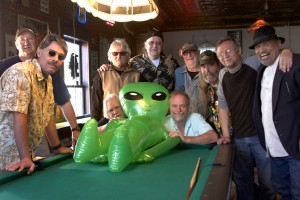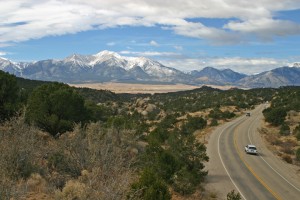by Susan Bavaria
Imagine a grand opportunity to pursue your creative craft unencumbered by phone, to-do lists or obligatory conversation for 30 days in a picturesque part of Colorado. Sound ideal? An artist residency makes it possible.
Artist residency programs exist worldwide, offering as much variety as there are interpretations of art. Some enjoy illustrious, historic reputations. Author Willa Cather toiled over Death Comes for the Archbishop at MacDowell Colony in New Hampshire. Composer Aaron Copeland as well as author Sapphire, who wrote the book that became the movie called Precious, both found inspiration at the Yaddo Artist Colony in Saratoga Springs, N.Y.
From April 24-May 24, Salida will host a unique residency program sponsored by Colorado Art Ranch. Since its inception in 2005, the group has sponsored residencies in rural towns around the state. Its 30-day residencies in painting, sculpting, drawing, photography, writing or mixed media have attracted writers and visual artists from around the world. Since the group owns no real estate, they take a “nomadic” approach says executive director Grant Pound and can expose artists to Colorado’s varied, often dramatic terrain.
“The landscapes of Colorado, open meadows, rock outcroppings and mountain views, inspire artists at a visceral level,” he says. “The simplicity of the setting becomes a dramatic foil for the residents’ struggle to express complex ideas.”
The only requirement of the seven residents is to give one day back to the community in any way they see fit. An art buddy from the community assigned to each resident helps with the logistics of setting this up.
Former Colorado Art Ranch resident Alex VanArk of Forest Hills, N.J. taught a creative nonfiction workshop at the local library as his give-back day activity and loved the experience. His only regret is that the length of the residency is only 30 days. When asked how the landscape affected him, he says, “I wrote more poetry. I started to express ideas more quickly.” The novel he had come out to here to write became a screenplay. “It was a joy to work and socialize with the community,” he says. “It colors my life every day.”
A second reason they alter locations is to allow participation by local and regional residents in a three-day public forum called an Artposium held in the town where residencies occur. Past Artposia have focused on a particular theme inspired by local environmental issues, social concerns, politics, science and history. Artposium speakers introduce participants to fresh ways of seeing and connecting the world, and attendees usually come away with new ideas and creative energy.
“The Artposia are designed for people who appreciate literature, contemporary art and the multidisciplinary exploration of ideas,” says Pound. Or as one participant says, “It’s like a thinkfest!”
Past themes range from Sex and Sensibility (Trinidad) and Plains, Frames & Land Use Ideals (Steamboat Springs) to the intriguing Mapping in the Arts: Ways of Seeing (Durango). This year’s seventh Artposium, Wade in the Water, features a stimulating line-up of guests.
Naturalist/explorer Craig Childs delves into archaeology, natural sciences and mind-blowing wilderness journeys. Author of more than a dozen acclaimed books, he will deliver the opening lecture on Friday evening, The Secret Knowledge of Water. A sample of his observant prose may whet the appetite for more:
Working in the stillness of a botanic garden, I put down my pen and notice a toad hidden among leaves and water pools. The animal looks like mottled stone, forelegs gathered at its breast. After a moment of appreciating its solitary toadness, I become acutely aware of the piped in sound of chirping frogs and cannot help wondering if the recorded loop is slowly driving him mad.
Gregory Hobbs, a Colorado Supreme Court Justice, used to practice water, land and environmental law. He is vice president of the Colorado Foundation for Water Education, co-convenor of the Western Water Judges Project and a published writer and poet. On Saturday, he will speak on The Politics of Water.
Third presenter Basia Irland will deliver a talk based on the water projects in her book Water Library on Sunday. She creates international water projects and often works with scholars from diverse disciplines. She once launched carved ice books embedded with seeds into rivers to aid with stream bank restoration. Her Desert Fountain, created for the Albuquerque Museum, relies on harvested rain or snow and can flow for 30 hours from one 50 gallon storage tank. During a severe drought, it was the only flowing fountain in the state.
The Artposium will be facilitated by activities, discussions, and workshops that promise to enliven, enlighten, and give attendees a fresh look at the way one sees, uses, enjoys, and controls water. The seven Colorado Art Ranch artist residents will also share their work and experiences with the audience at a special reception Saturday night.
“If you love water, if you drink water, if you’re curious, if you believe that arts are a catalyst for change, if you are inspired by interdisciplinary thought where visual arts and sciences are brought together for new perspectives, Wade in the Water is the preeminent venue and event for you,” says Pound.
Artposium: Wade in the Water takes place on May 21-23, 2010 at the SteamPlant Events Center in Salida. Tickets for individual lectures or the entire weekend are available at coloradoartranch.org.
Colorado Art Ranch recently landed a promotions coup by having the Denver International Airport Art Program offer them one of its high-profile exhibit spaces through April, 2010. On the walkway to the “A” concourse, an exhibit titled 33 IDEAS! features 33 works from those who have been nomads, speakers or residents of Colorado Art Ranch. Works demonstrate how the artists use their passion, skills and knowledge to address, envision or question human and land issues.
Susan Bavaria finds inspiration for her writing on Methodist Mountain even though she was raised a Catholic.

